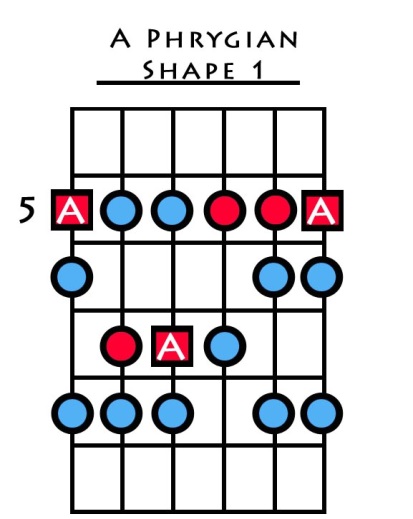The Phrygian Mode
The Phrygian mode is less commonly used in pop music, but it is not unusual to find it in heavy rock, metal and flamenco. It has a uniquely dark yet palatable sound with the unusual b9th in its construction giving it a somewhat Spanish flavour.
Phrygian is often used as a soloing choice over power chords in rock music, but is not often used as a source of diatonic chord progressions. As it is similar in construction to the Aeolian mode, they are often used interchangeably with one another.
Compositions that make use of the Phrygian mode:
War – Joe Satriani
Wherever I May Roam – Metallica
Formula and Harmonisation of the Phrygian Mode
The formula for the Phrygian mode is:
1 b2 b3 4 5 b6 b7
It is played like this on the guitar in the key of A:
Visualise the Phrygian mode around the A minor chord highlighted in red.
When harmonised, Phrygian gives the following series of chords:
| TRIAD Chord Type | SEVENTH Chord Types | Example in the key of A Phrygian |
|
i minor |
i minor 7 (extensions b9, 11, b13) | A minor 7 |
| bII major | bII major 7 (extensions 9, #11, 13) | Bb major 7 |
| biii major | biii 7 (extensions 9, 11, 13) | C7 |
| iv minor | iv minor 7 (extensions 9, 11, b13) | D minor 7 |
| v minor b5 | V minor 7b5 (extensions b9, 11, b13) | E minor 7b5 |
| bVI major | bVI major 7 (extensions 9, 11, 13) | F major 7 |
| bvii minor | bvii minor 7 (extensions 9, 11, 13) | G minor 7 |
However because of Phrygian’s very dark nature, writing chord progressions using only diatonic chords can sound somewhat awkward. As mentioned previously, in rock guitar we can get around this by using riff-based power chord backings and simply using the Phrygian mode over them, or we can use upper structure triads (slash chords) to imply the complex Phrygian over a simple bass pattern.
Typical Phrygian Chord Progressions
Dissecting the Phrygian Mode Part 2 – Licks, Intervals and Triads in The Phrygian Mode
These lessons on how to dissect modes for guitar are a sample of the much more comprehensive work:
“The artists you work with, and the quality of your work speaks for itself.”
Tommy Emmanuel
© Copyright Fundamental Changes Ltd 2025
No.6 The Pound, Ampney Crucis, England, GL7 5SA





